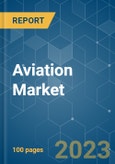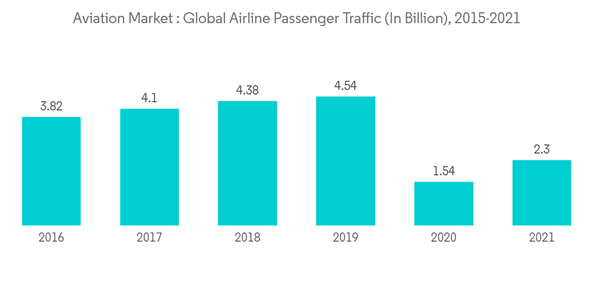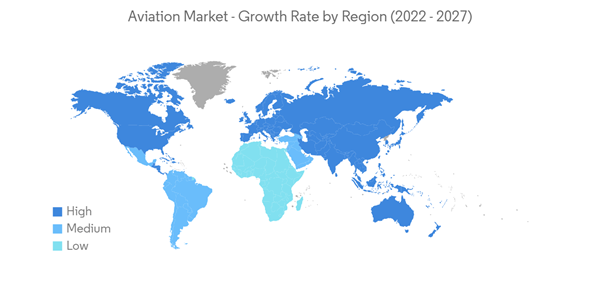The COVID-19 pandemic affected the aviation market in many ways, and the effect of the pandemic is expected to continue even during the forecast period. In the commercial sector, passenger traffic fell dramatically in 2020 and 2021. However, the aviation industry has started to improve during 2022 and is gradually returning to its pre-COVID-19 level. According to the latest updates from IATA, ICAO, the Airports Council International (ACI), the UN World Tourism Organization (UNWTO), the World Trade Organization (WTO), and the International Monetary Fund (IMF), the international air passenger traffic in 2022 has improved compared to that of 2021. The international air passenger traffic in June 2022 increased by 229.5% compared to June 2021, and the revenue passenger kilometers (RPK) in June 2022 reached 65% of that of June 2019.
There has been a significant rise in demand for helicopters and business jets to transport medical supplies, cargo, VIPs, and charter operations. Thus, the aforesaid factors are expected to propel the growth of the market. The orders and deliveries improved during 2022 compared to 2021, signifying the growth in demand for general aviation aircraft and recovering the market to its pre-COVID-19 level.
Several manufacturers are now focusing on developing newer generation aircraft in various aviation segments. The newer generation aircraft offer better fuel efficiency and safety for commercial and general aviation customers and better situational awareness and tactical advantage for military customers. The advent of such aircraft is expected to drive market growth during the forecast period.
Aviation Market Trends
Commercial Aircraft Segment Projected to Witness the Highest CAGR During the Forecast Period
In 2020, there was a decline in commercial aircraft deliveries due to the COVID-19 pandemic. However, aircraft deliveries improved in 2021, and the major commercial aircraft OEMs, like Airbus and Boeing, increased their aircraft production and delivery rates. With the lifting of travel restrictions, air passenger traffic is improving. With the increase in air passenger traffic, airlines have started operating on all major routes and have also added new routes. United Airlines has announced that it has started operating on new routes, describing it as its 'largest transatlantic expansion.' With everything returning to normal, new airlines have started operations. Akasa Air, a new Indian airline, has started its operations in August 2022, starting with one route with 28 flights a week and gradually adding two more routes. In October 2022, Alaska Airlines placed an order for 52 Boeing 737 MAX aircraft with a plan to expand its fleet. The airline announced plans to have an all-Boeing mainline fleet by the end of 2023.With the e-commerce operations increasing rapidly since COVID-19, the air cargo market has increased, and thus the orders for freighter aircraft have increased in 2022. For instance, in October 2022, Luxembourg's Cargolux airlines placed an order with Boeing for 10 777-8 freighters along with options for 6 additional aircraft. China holds the position of second largest air freight market only next to the United States. According to Boeing's Commercial Market Outlook 2022, China's commercial airfleet is expected to grow from 3900 to 9600 by 2041.
Asia-Pacific Expected to Dominate the Aviation Market During the Forecast Period
Asia-Pacific has become a significant hub for the aviation industry over the years. The emerging economies in the region, like India and China, are experiencing a massive surge in their respective civil aviation markets due to an increased demand for air travel. Hence, the revenues from Asia-Pacific are projected to witness a high growth rate during the forecast period.China is leading the recovery of global commercial aviation due to great domestic demand, helping the airlines witness financial recovery. It has become a major hub for the aviation industry over the years due to high demand from civilian and military customers. Commercial aviation has been a key contributor to China's aviation industry over the years. China is the largest market in aviation due to an increase in domestic air passenger traffic, which has surpassed the North American region and is expected to grow rapidly at a rate of 4.4% by 2040, according to Boeing. An increase in the number of airports in the region would also help in the growth of the market. In March 2022, the Indian aviation ministry approved the construction of 21 greenfield airports in the country. New airlines in the region have also helped to improve the market.
With the increase in military spending of the countries in the region due to tensions between neighboring countries and with foreign nations investing in arranging military base stations in countries like Australia, military aviation in the Asia-Pacific region is also increasing. China is increasing its military airborne capabilities, and a new stealth fighter aircraft, the new version of the J-20, which is the world’s first twin-seat stealth fighter aircraft, was unveiled in October of 2021.
Aviation Market Competitor Analysis
The global aviation market is moderately consolidated, occupied by major manufacturers like Airbus SE, the Boeing Company, Lockheed Martin Corporation, Embraer, and Textron Inc., catering to market needs. The rivalry between The Boeing Company and Airbus SE continued during 2022, mainly in the commercial aviation sector. Along with Lockheed Martin Corporation, a key player in the military segment, these two companies have maintained their market dominance for over a decade now. Though Boeing's commercial segment revenues were down in the last two years, a strong performance in the defense segment has helped it gain a significant market share. The aviation industry is expected to witness innovations implemented in aircraft design, which are likely to alter the meaning of safety, comfort, and efficiency for commuters. Companies are looking for opportunities offered by the latest technological innovations that can help them improve revenue shares. The military segment of the market is witnessing increased collaborations between the players to develop next-generation combat and non-combat aircraft, which is expected to help the players' collective growth during the forecast period.Additional benefits of purchasing the report:
- The market estimate (ME) sheet in Excel format
- 3 months of analyst support
This product will be delivered within 2 business days.
Table of Contents
Companies Mentioned (Partial List)
A selection of companies mentioned in this report includes, but is not limited to:
- The Boeing Company
- Airbus SE
- Embraer SA
- Textron Inc.
- Lockheed Martin Corporation
- Bombardier Inc.
- PILATUS AIRCRAFT LTD
- Leonardo SpA
- Honda Aircraft Company
- Piper Aircraft Inc.
- General Dynamics Corporation
- Dassault Aviation SA
- Cirrus Design Corporation
- Diamond Aircraft Industries










